Why you can trust TechRadar
The Acer Aspire S7, like most Core i5-packing laptops, performs admirably. Couple that with plenty of RAM and a snappy SSD, and it becomes tough to slow this system down with the everyday tasks and apps that folks are most likely to use on it, much less with benchmarks. The results failed to send me reeling:
- 3DMark: Ice Storm: 41,360; Cloud Gate: 4,429; Fire Strike: 644
- Cinebench CPU: 231 points
- PCMark 8 Battery Life: 2 hours, 57 minutes
These numbers are directly in line with how the Dell XPS 13 scored, and the 13-inch MacBook Air reported similar Cinebench results in my experience. That said, the Aspire S7 takes a hit in battery life, likely thanks to those extra pixels its pushing. While the PCMark 8 battery test is conducted on the laptop's "High performance" setting and with the screen at its highest brightness, this machine didn't fare much better under more favorable conditions.
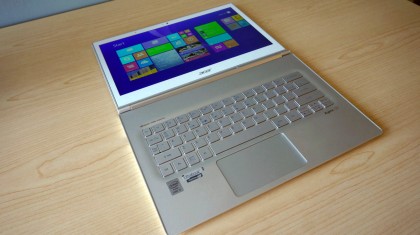
To get a sense of a how long the Aspire S7 could last under what I consider a normal workload, I knocked the screen brightness down to 60%, the power setting to "Balanced", the volume to around 20% and kept the keyboard backlit. Then, I ran Google Chrome with over 10 tabs open, Spotify streaming high bitrate audio, an image-heavy chat app, TweetDeck and a PDF reader. Doing this, with the occasional HD video, the Aspire S7 lasted 4 hours and 55 minutes.
That figure is well below Acer's claim of up to 7 hours of battery life, though Acer has its own parameters for testing endurance. This puts the Aspire S7 in the same class as the XPS 13 (4 hours and 33 minutes on a similar test). And while neither can hold a candle to the MacBook Air's true 7- plus hours of lasting power, remember its far lower pixel count and low-frequency CPU.
Super sharp, but super necessary?
The Aspire S7 is one of Acer's first laptops to come rocking a 2560 x 1440 display, or what the marketers call WQHD. (Which literally stands for "Wide Quad High-Definition." No, really.) But, as with all device screens that have gone beyond HD, it begs the question, "Do we even need such high resolutions?"
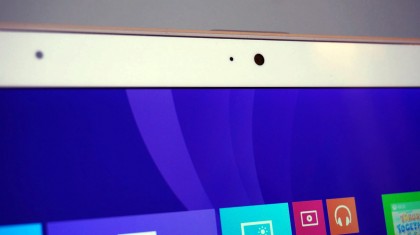
Make no mistake, 1080p is not the end of the road for screen sharpness. The TV industry shows as much every single January at CES. But it's the content, not to mention the pipes and software, that need some catching up. While watching a 3-minute video in 1440p on the Aspire S7, not only did it have to buffer every 20 seconds, but YouTube's intense compression made for an image that looked barely 720p.
I like to think that I have an OK wireless internet connection, able to stream full HD video to my TV through Netflix and other apps without issue. That I could barely get through 3 minutes of 1440p video is telling of whether WQHD or UHD or WQUVWXYZHD is even necessary yet. That said, I enjoyed reading articles online with nary a pixel showing through Internet Explorer – Chrome has yet to catch up on Windows. Plus, the Gorilla Glass bezel and screen made touch gestures feel seamless, if still unecessary.
Acer cares for the keyboard
Now, this is a company that understands the importance of a laptop's keyboard, especially when it comes to a premium machine. Acer even claims to have adjusted the depth of each key's travel by three tenths of a millimeter. While I can't necessarily tell the difference, I can say that it makes for quite a snappy typing experience.
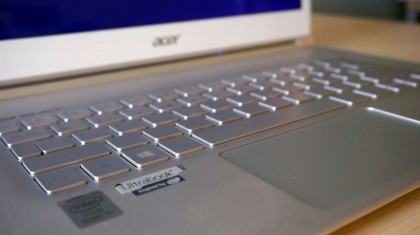
What's even more interesting is this keyboard's backlighting. Acer's electroluminescent backlighting is said to be a gentler, thinner lighting solution for keyboards than LEDs. The result is an aquamarine glow emanating from each key, which the company says produces less bleeding light than LEDs. This might be true, but I've noticed some bleed here and there. The sci-fi-like effect that turning on the backlight produces, illuminating the keys slowly and dramatically, is more exciting anyway.
As for the touchpad, I've had no issues scrolling through web pages, clicking and dragging files or summoning the Windows 8.1 Charms menu. The tracking space is nice and wide, albeit lacking a bit of depth. And it would be nice if Acer centered the touchpad in reference to the keyboard deck – not the space bar.
Before moving on, Acer's goofy key layout won't get off scot-free. For one, the Caps Lock and Tilde keys are smushed together where otherwise a single Caps Lock key would be. There's also the Delete key nudged next to the navigation keys, and the function keys superimposed on top of the number keys. A six-row keyboard would be nice, but the trade-off might have been a much hotter laptop.
Not so hot, hot heat
Any other Ultrabook this thin would easily double as a heating pad. Not so with the Aspire S7. Acer has employed an upgraded cooling method with this laptop, dropping the amount of blades in each of its two fans (one for intake, one for output) from 29 to 23. Acer claims that this thermal design grants a boost to battery life.
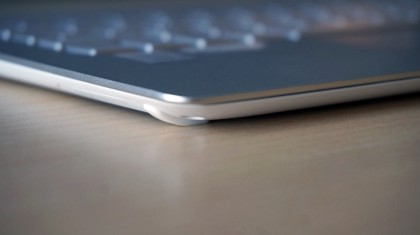
But all I've noticed is a much cooler, quieter laptop than most in Intel's Ultrabook class. So much as an HD video would cause most thin-and-light notebooks to burn up, whereas the Aspire S7 keeps it cool. This is a boon for travelers and couch potatoes alike.
Bundled software
Acer is extremely light on bloatware, to the point of being dull. It's nevertheless an admirable move, but aside from some PureVoice microphone-enhancing tech and a user guide PDF masquerading as an app, there are only three original or third-party apps to speak of. The upside? Plenty more of that 128GB SSD is available to you from the start.
- IDCard: Nothing more than a window detailing your PC's identity, which is useful for support-related purposes.
- Live Updater: This pulls driver and software updates right from Acer's servers, eliminating the need to go to Acer's website to keep current.
- Recovery Management: An easy way to restore your PC to its factory settings and reinstall drivers, though Windows already offers these tools inherently.
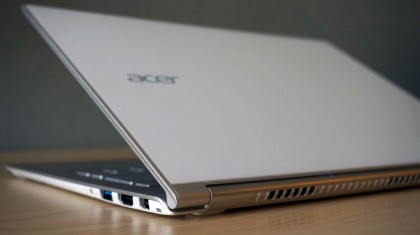
Joe Osborne is the Senior Technology Editor at Insider Inc. His role is to leads the technology coverage team for the Business Insider Shopping team, facilitating expert reviews, comprehensive buying guides, snap deals news and more. Previously, Joe was TechRadar's US computing editor, leading reviews of everything from gaming PCs to internal components and accessories. In his spare time, Joe is a renowned Dungeons and Dragons dungeon master – and arguably the nicest man in tech.

